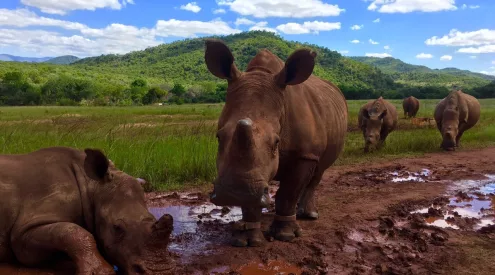The so-called ‘Wilderness‘ section of the Garden Route National Park is astoundingly beautiful. It consists of a series of large lakes fed by the Touw River, and these lie between the traditional Knysna forests and a beach more than 30 kilometres long.
The four lakes are world-renowned birding sites, and two of them – Langvlei and Rondevlei – are RAMSAR sites, an international accreditation, meaning that they are protected from all human interference or development. You’re not even allowed to canoe on them.
The Ebb & Flow campsite lies at the end of the thickly-forested Touw River gorge. Indigenous trees – huge Outeniqua Yellow Woods, Saffron, Ironwood, Beach and Real Yellow Wood trees – cover the gorge. Without a doubt the best way to see the gorge is to paddle up the dark, clear waters on a canoe. Eden Adventures, which are based at the rest camp, have been operating in the area for many years, and offer several activities, including canoeing.
The campsite is full of life. Knysna loeries are common, flying across the river from one tree to another, their scarlet wings catching the sunlight. Bushbuck and bush pigs are regular visitors – the former during the day, and the latter at night. Malachite kingfishers perch on the reeds alongside the river, while it’s kind of strange – but wonderful –that you can be woken by a cry of the resident Fish Eagles. It’s great to know that they thrive right here at the southern end of Africa. Long may that last.
But as pristine as the environment looks, there’s a huge amount of development. Houses have been built too close to the water’s edge. And some pretty garish houses – several stories high – have been constructed on top of the ridges of the gorge…standing out like sore thumbs above the forest line. I can’t understand how people can have so little consideration for the sense of place.
The lakes are fed by the Touw River, which, for most of the year, is stopped from flowing into the sea by huge amounts of sand deposited across the mouth by the ocean currents. In particularly rainy years, the river develops enough power to break through the silt, and the lakes can release the excess water. However, these days, the park has to artificially open the river mouth with bulldozers, otherwise the water will flood the houses which have been built near the water. So, I wonder what effect this has on the natural system?
Okay, so be it. The area is still beautiful…and there’s still plenty of birdlife, fish and wild animals.
The Wilderness section also includes a lot of the indigenous Knysna forests, in particular the area which was the inspiration for Dalene Matthee’s superb book Circles in a forest (originally written in Afrikaans as Kringe in ‘n bos). If you haven’t read this book, then do! At the risk of over-simplification, it’s about a young man – Saul Barnard – who is born into a family of woodcutters who live in the forest. He soon has to confront his family, his society and his own conscience over the slow destruction of the forests and animals – most notably the elephants (which were known as Big Feet).
During the 19th century, thousands and thousands of hectares of ancient forests were felled to quench the huge demand for wood by the cities and towns. And of course, the famous elephants of the forest – the southern-most elephants in Africa – were shot out. Or were they?
It’s been the subject of much debate recently – SANParks rangers have seen one elephant…while others say there is more than one. No-one knows how many exactly. That’s because these mountainous forests are very thick indeed…it’s difficult to see more than a few metres in front of you. The fact is – there ARE still elephants around, and that is wonderful and is something that should never change.
I highly recommend visiting the Dalene Matthee memorial, which is in the middle of the forest near the old town of Millwood above Knysna. There’s a huge Outeniqua yellow wood tree right next to her memorial. And there is a great hiking trail – appropriately entitled Circles in a Forest – which runs from the memorial. It’s impossible not to have a deep, deep reverence for the ancient forests. And it’s even harder to accept that most of it has been chopped down, to make way for farms, towns, roads and – unbelievably – commercial plantations of exotic trees, like pine and blue gum.
Thanks very much to senior section ranger Nellie Grootendorst and field ranger Gerrit Slinger for showing me around the Wilderness section …
For more, go to www.yearinthewild.com and www.facebook.com/yearinthewild. Thanks again to my sponsors for making it all possible. CapeNature, South African National Parks, Ezemvelo KZN Wildlife, Eastern Cape Parks, iSimangaliso Wetland Park, Ford, Total, Evosat, Conqueror Trailers, Vodacom, Digicape, Lacie, Frontrunner, Safari Centre Cape Town, K-Way, EeziAwn, National Luna, Nokia , Goodyear, Global Fleet Sales, Hetzner, Clearstream Consulting and Escape Gear.


















